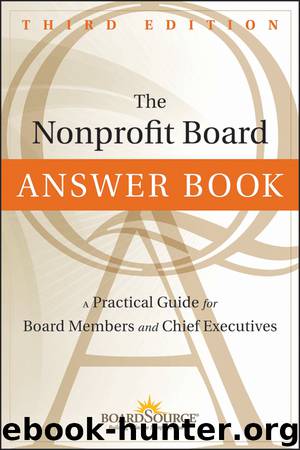The Nonprofit Board Answer Book by Boardsource

Author:Boardsource
Language: eng
Format: epub
Publisher: Wiley
Published: 2011-10-02T16:00:00+00:00
Investment Guidelines
Liquid reserves are funds available for investments. The reserve policy set by the board, taken together with the organization’s cash flow, will guide the type of investments selected. Most organizations have an operational cycle with high points and low points for revenue—a certain month or time of year when charitable contributions are received, a large program takes place, or dues are collected. If the organization’s balance drops to zero right before the expected influx of revenue, the organization would need to generate cash quickly. That situation would point to the need for short-term, low-risk investments such as Treasury bills and insured certificates of deposit. Even the cash needed to cover day-to-day operations can be invested in some way, such as earning interest on a checking account and not paying invoices until they are due.
Some organizations maintain a sweep account that’s equivalent to two or three weeks of day-to-day operations. The organization earns investment income on the account and has access to it each day; whatever is not spent is automatically reinvested.
In general, investment guidelines generally cover the following elements:
The organization’s overall investment philosophy and objectives. This philosophy guides long-term decisions, making organizations more likely to stay the course during turbulent economic times rather than panic and pull out all assets. An organization might abide by a 60:40 philosophy, such as having 60 percent in equities (mostly value stocks) and 40 percent in fixed assets.
What kinds of investments are allowed or prohibited. Each option involves a different degree of risk, investment yield, and ability to access the funds (liquidity). In general, the lower the risk, the greater the liquidity (think of a savings account that pays low interest but allows for withdrawal of funds at any time). An investment vehicle promising a higher yield also carries a higher risk (junk bonds, for example). Most nonprofit organizations take a conservative approach and aim for a mix of low-risk, short-term investments (those that mature within one to five years, such as mutual funds) and higher-risk, long-term investments (stocks and bonds held for more than five years). Some nonprofits are more aggressive and have adopted policies that allow them to invest in hedge funds and venture capital deals. Some are concerned with socially responsible investing. Thus they avoid supporting tobacco companies or corporations that use child labor, for example, or choose to support those companies that engage in environmentally safe activities.
Who is responsible for asset management. Boards usually delegate authority to the finance committee or investment committee to manage the investment process. Most experts agree that this committee should not actually manage invested funds, but instead supervise an outside investment adviser.
How investments should be allocated. What percentage should stocks represent? What percentage should be in bonds? The guidelines should provide the rationale for each class of assets selected and explain how, taken together, they offer balance and diversity.
How performance will be measured. At a minimum, investment yield should be reviewed quarterly. Decide what index to use as a performance benchmark, such as Standard & Poor’s 500.
Download
This site does not store any files on its server. We only index and link to content provided by other sites. Please contact the content providers to delete copyright contents if any and email us, we'll remove relevant links or contents immediately.
| Consulting | Entrepreneurship |
| Franchises | Home Based |
| Marketing | New Business Enterprises |
| Nonprofit Organizations & Charities |
Pioneering Portfolio Management by David F. Swensen(6226)
Man-made Catastrophes and Risk Information Concealment by Dmitry Chernov & Didier Sornette(5921)
Zero to One by Peter Thiel(5684)
The Motivation Myth by Jeff Haden(5155)
The Miracle Morning by Hal Elrod(4637)
Elon Musk by Ashlee Vance(4023)
The Art of Persistence: Stop Quitting, Ignore Shiny Objects and Climb Your Way to Success by Michal Stawicki(3623)
Unlabel: Selling You Without Selling Out by Marc Ecko(3587)
Delivering Happiness by Tony Hsieh(3363)
Urban Outlaw by Magnus Walker(3338)
Purple Cow by Seth Godin(3137)
Mastering Bitcoin: Programming the Open Blockchain by Andreas M. Antonopoulos(2980)
The Marketing Plan Handbook: Develop Big-Picture Marketing Plans for Pennies on the Dollar by Robert W. Bly(2975)
The Power of Broke by Daymond John(2895)
The Content Trap by Bharat Anand(2860)
Applied Empathy by Michael Ventura(2838)
The Airbnb Story by Leigh Gallagher(2797)
Keep Going by Austin Kleon(2696)
Radical Candor by Kim Scott(2667)
